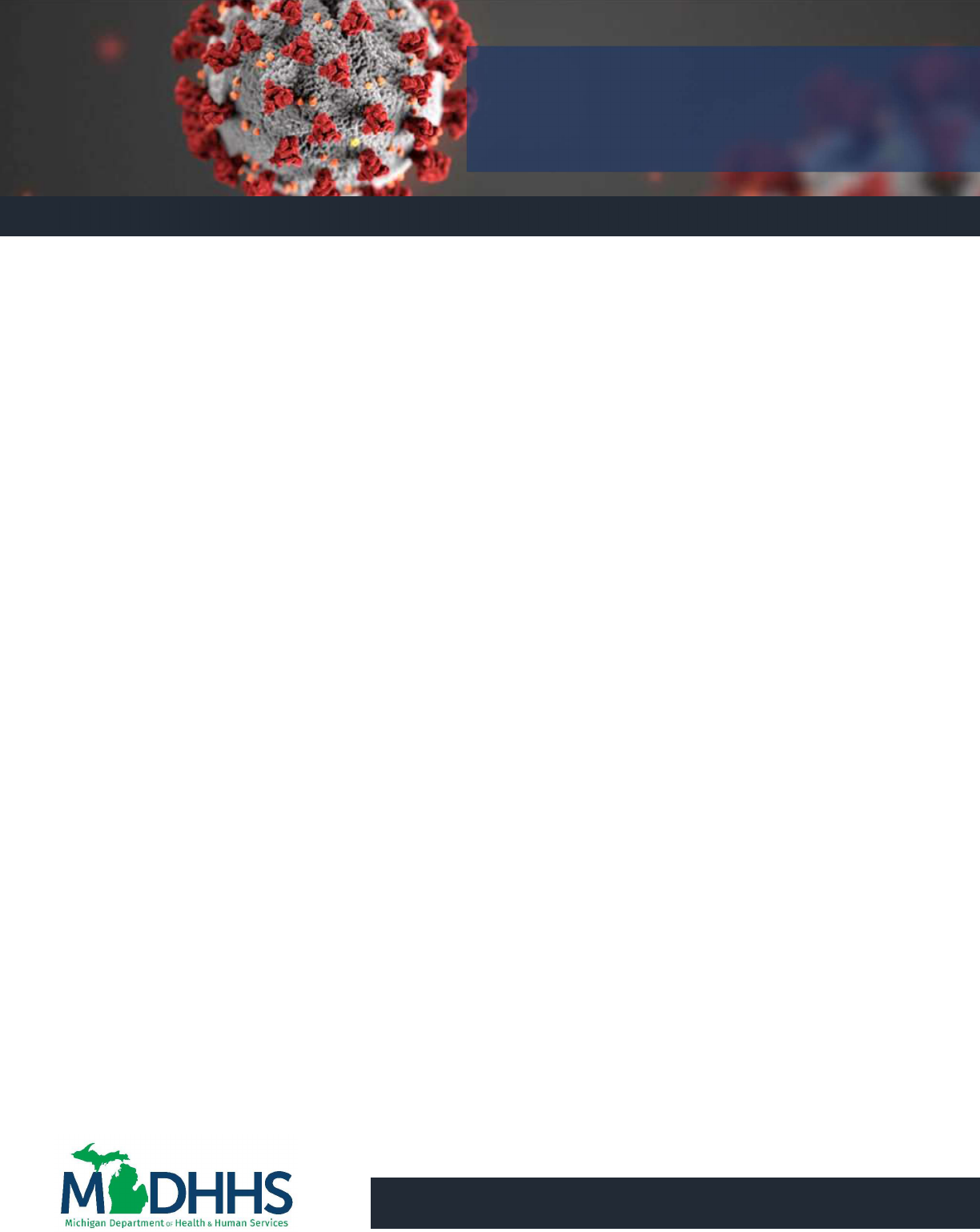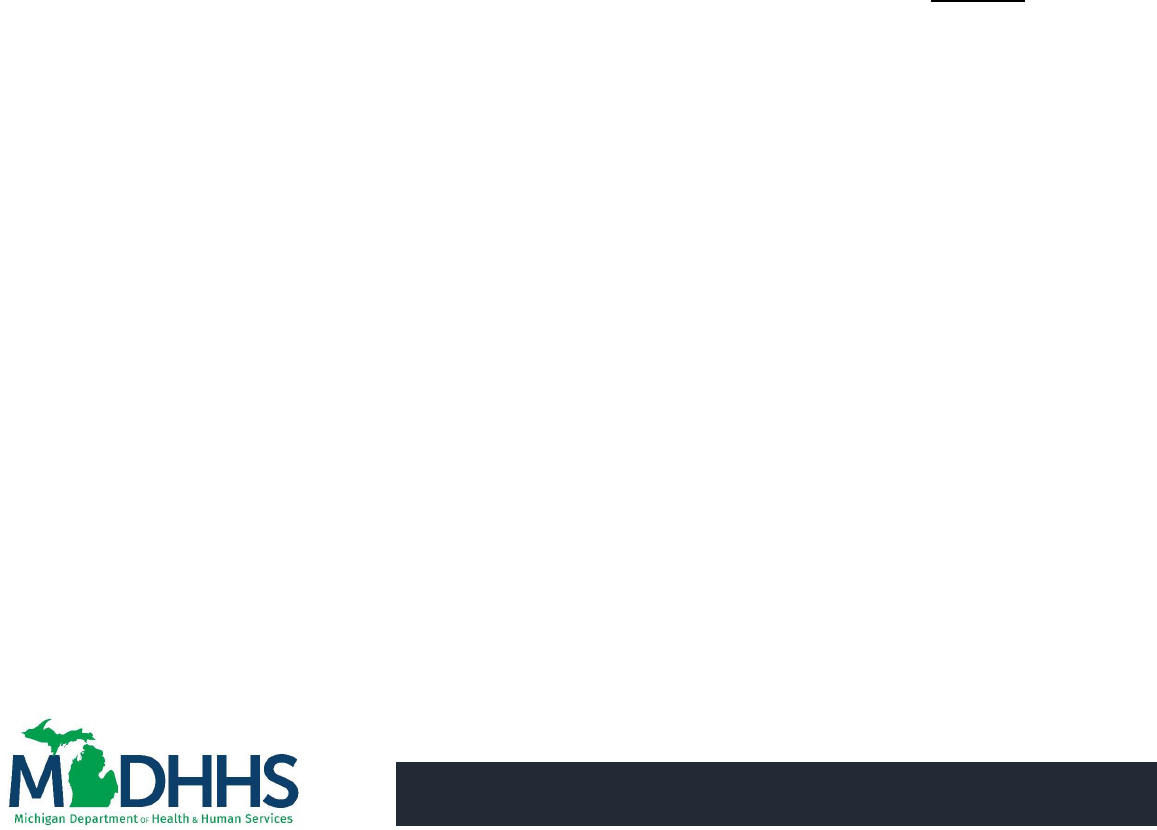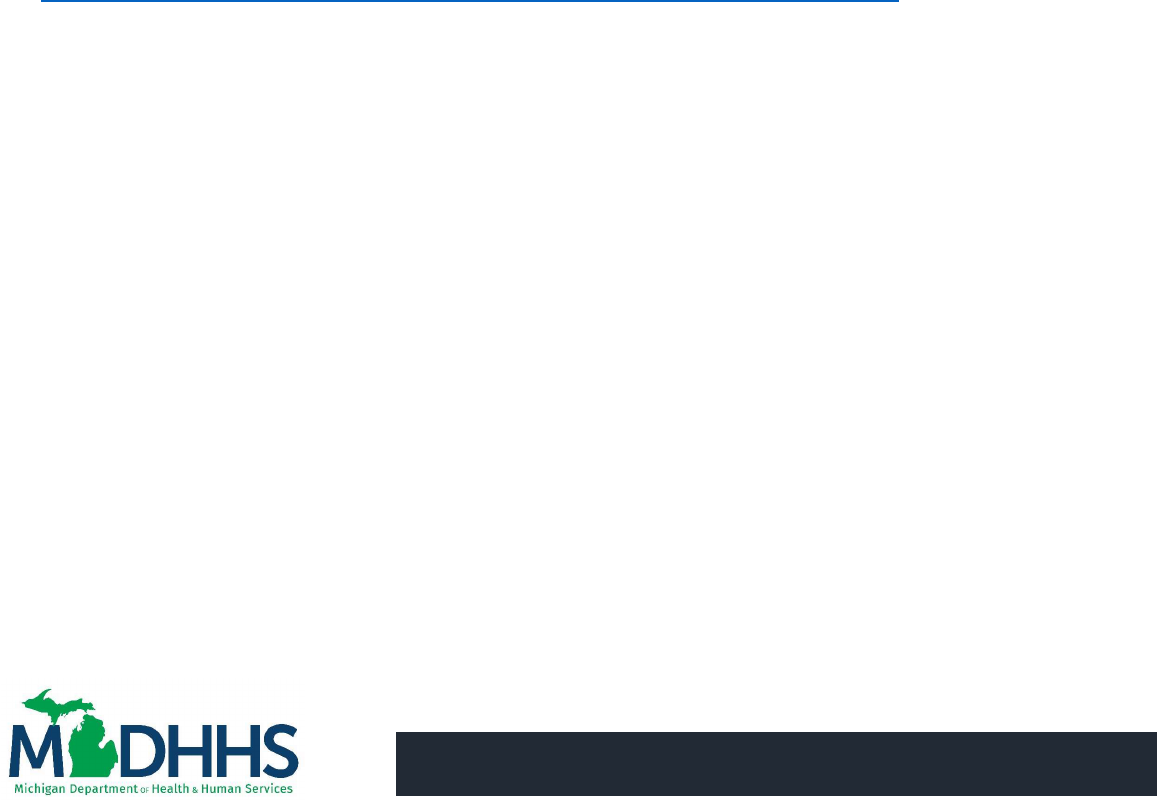
For more information
, visit
Michigan.gov/Coronavirus
.
03/21/2020
Guidance for Healthcare Worker Self-Monitoring and Work Restriction
In the Presence of Sustained Community Transmission of Coronavirus
Disease 2019 (COVID-19)
Executive Summary
The Michigan Department of Health and Human Services is currently reporting sustained
widespread community transmission of COVID-19 in multiple areas of the State. This guidance is
intended to help with the development of occupational health programs, policies, and priorities
for groups that are critical to the healthcare system in the State of Michigan and is applicable to
the following groups: hospitals, healthcare facilities, EMS, other organizations that employ
healthcare workers in the inpatient or outpatient setting, all providers and support staff involved
in patient care, and public health staffing actively involved in the COVID-19 response (local or
state).
This interim guidance should be considered alongside applicable state and federal regulations and
provided to all healthcare workers as appropriate. The primary recommendations in this guidance
include:
1) If you are sick, please stay home.
2) Healthcare workers currently prohibited from working because of previous guidance
may return to work if asymptomatic if they are able to be closely monitored by their
facility’s occupational health program and adhere to all requirements for self-
monitoring.
3) In the context of sustained community transmission of COVID-19, all healthcare
workers are at risk for unrecognized exposures. Therefore, ALL healthcare workers
should self- monitor for fever with twice-daily temperature measurements and for
symptoms consistent with COVID-19.
4) If you are a healthcare worker who has had a known high-risk exposure to a
patient(s) with confirmed COVID-19, you should take extra care to monitor your
health but can keep working. There is no requirement for 14-day quarantine of
healthcare workers with high-risk exposures in the setting of sustained community
transmission as we have in multiple areas of the State of Michigan.
Guidance for Healthcare Worker
Self-Monitoring and Work
Restriction
Michigan.gov/Coronavirus

For more information
, visit
Michigan.gov/Coronavirus
.
03/21/2020
5) MDHHS advises against testing of any asymptomatic individuals with or without an
exposure to COVID-19, including healthcare workers.
6) If you feel overwhelmed and need support to cope with the situation, contact the
SAMHSA Disaster Distress Hotline at 800-985-5990.
Detailed Recommendations
The Michigan Department of Health and Human Services is currently reporting sustained
widespread community transmission of COVID-19 in multiple areas of the State. This guidance is
intended to help with the development of occupational health programs, policies, and priorities
for groups that are critical to the healthcare system in the State of Michigan and is applicable to
the following groups: hospitals, healthcare facilities, EMS, other organizations that employ
healthcare workers in the inpatient or outpatient setting, all providers and support staff involved
in patient care, and public health staffing actively involved in the COVID-19 response (local or
state).
This interim guidance should be considered alongside applicable state and federal regulations and
provided to all healthcare workers as appropriate.
If you are sick, please stay home.
If you have a new onset of fever (subjective or temperature of ≥100.0⁰F* or 37.8°C) OR symptoms
of possible COVID-19 syndrome (cough OR shortness of breath OR sore throat), you MUST STAY
HOME and immediately notify your supervisor.
For mild illness consistent with COVID-19, healthcare workers must stay home 7 days following
onset of illness or 72 hours after being consistently afebrile without use of antipyretics and with
resolving respiratory symptoms, whichever is longer. However, at the completion of isolation,
healthcare workers should check with their employer before returning to work.
If your symptoms are severe (e.g., difficulty breathing) enough that you feel that you need to see a
healthcare provider but it is not an emergency, contact the healthcare provider before you seek
care and alert them that you are a health care worker who may have been exposed to a person
with COVID-19. You should put on a mask and ideally take a private vehicle to travel to your
healthcare provider. When arriving at the healthcare facility, let the staff know that you are ill and
had a possible exposure to COVID-19. If it is an emergency and you call 911, alert the operator
that you may have been exposed to a person with COVID-19 and describe your symptoms.

For more information
, visit
Michigan.gov/Coronavirus
.
03/21/2020
All healthcare workers:
In the context of sustained community transmission of COVID-19, ALL healthcare workers
should self- monitor for illness consistent with COVID-19 because all healthcare workers are
at risk for unrecognized exposures. The purpose of self-monitoring is to identify illness early
and self-isolate at home to reduce the potential of transmission to those you care for. As a
healthcare worker you should self-monitor by taking your temperature twice daily and evaluating
yourself for COVID-19 like illness which include any of the following:
measured temperature >100.0°F* (37.8°C) or subjective fever
cough
shortness of breath
sore throat
*Fever cutoffs are different in guidance for the healthcare workers. This is done to recognize
illness early.
Timing of these checks should be at least 8 hours apart with one check immediately before each
healthcare shift. If any of these signs/symptoms develop, then DO NOT come to work. If
symptoms develop at work, you should immediately leave the patient care area, self-isolate, and
notify your supervisor.
Healthcare worker with HIGH-Risk exposure to a confirmed or probable COVID-19 patient:
If you are a healthcare worker who has had a known high-risk exposure to a patient(s) with
confirmed COVID-19, you should take extra care to monitor your health but can keep
working if you are able to be closely monitored by their facility’s occupational health
program and adhere to all requirements for self-monitoring. There is no requirement for
14-day quarantine of healthcare workers with high-risk exposures in the setting of
sustained community transmission as we have in multiple areas of the State of Michigan.
High-risk exposures include: 1) an unmasked provider having prolonged close contact (<6 feet for
more than a few minutes) with an unmasked confirmed COVID-19 patient; 2) a provider not
wearing eye protection while present for an aerosol generating procedure (e.g. cardiopulmonary
resuscitation, intubation, extubation, bronchoscopy, nebulizer therapy, sputum induction); 3) an
unmasked provider present for an aerosol generating procedure. MDHHS asks that you self-
monitor at least twice daily for symptoms listed above (subjective fever or measured temp
>100.0°F, or cough, or shortness of breath or sore throat) AND additional new onset lower acuity
symptoms that may be associated with early signs of infection with COVID-19 including muscle
aches, or malaise (feeling tired or run down), or runny nose, or stuffiness, or congestion.
Timing of these checks should be at least 8 hours apart with one check immediately before each
healthcare shift. If any of these signs/symptoms develop then you MAY NOT come to work. If
symptoms develop at work, you MUST immediately leave the patient care area, isolate yourself
and notify your supervisor.

For more information
, visit
Michigan.gov/Coronavirus
.
03/21/2020
Additional precautions for asymptomatic healthcare workers exposed to a possible or
confirmed COVID-19 patient:
In the context of sustained community transmission of COVID-19, all healthcare workers are at
some risk for exposure at work and within the community. CDC has advised that healthcare
facilities consider allowing asymptomatic healthcare workers exposed to a confirmed COVID-19
patient to work while wearing a surgical mask (https://www.cdc.gov/coronavirus/2019-
ncov/downloads/community-mitigation-strategy.pdf). MDHHS again stresses that ALL providers
should be self-monitoring and if sick, stay home.
Given the limited availability of personal protective equipment, use of surgical masks by
asymptomatic exposed providers at work should be limited to those who have had known high-
risk exposures or are involved in care of vulnerable patients (e.g., age ≥50, chronic lung disease
(e.g., asthma, COPD), heart disease, diabetes immunocompromised).
Testing of asymptomatic healthcare workers:
In keeping with CDC guidance, MDHHS advises against testing of any asymptomatic individuals
with or without an exposure to COVID-19, including healthcare workers, especially given current
shortages in PPE, collection swabs, viral transport media and testing reagents. Healthcare workers
should not be tested as a precondition of returning to work since a negative test result does not
provide assurance that that healthcare workers within 14 days of a high-risk exposure will not go
on to develop symptoms of COVID-19 after they are tested. However, while it is not yet known
what role asymptomatic infection plays in transmission, if testing is done against public health
recommendations, asymptomatic healthcare workers who have a positive test result for COVID-19
should NOT go to work. The healthcare worker should monitor their health at home for COVID-19
like illness for a total of 7 days from the date of specimen collection. If the healthcare worker
remains symptom free, they may return to work after that 7-day period. If the HCW develops
COVID-19 like illness during the 7-day self-monitoring period, they will need to self-isolate for an
additional 7 days from symptom onset or until they have been afebrile for 72 hours off
antipyretics, whichever is longer, before they return to work.
Note: your employer may require you to report your temperature and symptoms daily (i.e.,
active monitoring) and may have additional guidance for specific employees caring for high-
risk populations such as the elderly or immune compromised.

For more information
, visit
Michigan.gov/Coronavirus
.
03/21/2020
Support for healthcare workers experiencing anxiety
During the monitoring period, it is normal for you and family members to feel distressed, anxious
or afraid. Try to keep a hopeful outlook and strengthen your resilience by drawing on your skills
that helped you manage difficult situations in the past. Keep in touch with other relatives and
friends by phone, email or social media. If you feel overwhelmed and need support to cope with
the situation, contact the SAMHSA Disaster Distress Hotline at 800-985-5990.
* Fever is either measured temperature >100.0 degrees F or subjective fever. Note that fever may
be intermittent or may not be present in some patients, such as those who are elderly,
immunosuppressed, or taking certain medications (e.g., NSAIDs). Clinical judgement should be
used to guide testing of patients in such situations. Respiratory symptoms consistent with COVID-
19 are cough, shortness of breath, and sore throat. Medical evaluation may be recommended for
lower temperatures (<100.0°F) or other symptoms (e.g., muscle aches, nausea, vomiting, diarrhea,
abdominal pain headache, runny nose, fatigue) based on assessment by public health authorities.
Additional Resources:
Interim U.S. Guidance for Risk Assessment and Public Health Management of Healthcare
Personnel with Potential Exposure in a Healthcare Setting to Patients with Coronavirus Disease
(COVID-19)
(Additional Considerations and Recommendations)
https://www.cdc.gov/coronavirus/2019-ncov/hcp/guidance-risk-assesment-hcp.html
